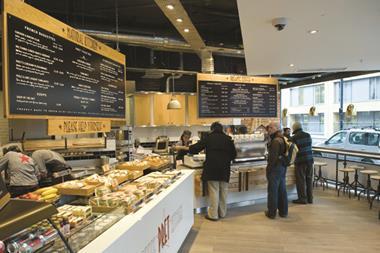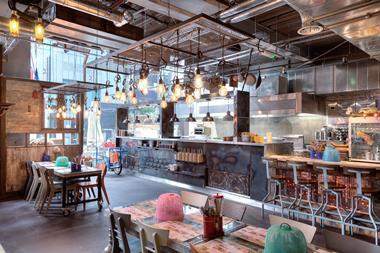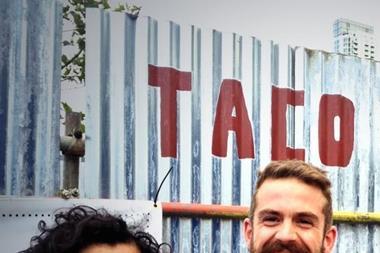Street food, and all it entails whether that is through food, marketing or location, has become an increasingly influential part of the UK’s eating and drinking-out sector. Over the next few months and years that influence is set to further grow as the category evolves with the help of a number of established players. At the same time, the UK’s health-focused food to go sector is reaching a tipping point, with a consolidation play coming into view.
Almost half of respondents to M&C Allegra Foodservice’s recent UK Restaurant Report 2015, highlighted street food as the sector set to grow fastest over the next three to five years, followed by all day dining and food to go. Nearly four-fifths stated that street food is here to stay, while its influence is such that over half (51%) of industry executives believe operators have to feature provenance and artisanal products to enhance value to customers.
The UK’s street food market currently stands at just under 7,000 outlets with an annual turnover of just under £5m. To put this in perspective, the UK’s branded fast food sector currently has 4,634 outlets with an annual turnover of just over £5m. Sales growth (CAGR) across street food and mobile van operators increased 14.2% in the three years to 2015, against a 4.6% rise in branded traditional fast food. Over the next three years CAGR across street food and mobile vans is forecast to rise by 16.4% against a 4.2% climb in the branded traditional market.
Growth in fast food will be increasingly driven by fast food operators and branded emerging fast food concepts (fast-casual), the latter having been greatly influenced by the former.
The growth of street food has seen established operators tweak existing models (the new KFC design), try new formats (Thaikhun from the Thai Leisure Group or D/F Mexico from the already street food-influenced Wahaca), and incorporate new menu formats (Mitchells & Butlers with its Ruby Jean’s Diner concept across its Castle estate). It has also provided opportunities for landlords to constantly refresh food courts, such as Trinity Kitchen in Leeds; and this summer train station concourses, in the shape of SSP’s link up with a handful of street operators such as The Ribman and Big Apple Hot Dogs at Euston.
In terms of location, previously unloved London satellite suburbs such as Brixton, Dalston, Peckham, Vauxhall and Stoke Newington, or even secondary locations in central London (helped by the success of MEATliquor and Inceptions Group’s mantra of “wrong street right postcode”) are now the hunting ground for fast-growing brands, put off by the premiums sought in the City and the West End. Take the expansion plans of Turtle Bay, the Piper-backed concept founded by Las Iguanas co-founder Ajith Jaya-Wickrema, which has already opened in Walthamstow and has Dalston, Brixton, Tooting and Peckham on its radar. It is thought to have beaten off competition from the likes of Honest Burger and Pizza Pilgrims to secure a site in the latter location.
But what next for street food, especially for those trying to emerge and also for landlords/developers looking to merge the best of both worlds (street food and established operations)? One answer could come from a pair of established sector operators.
Earlier this year, it was revealed that Jonathan Downey, partner in the nomadic night market Street Feast, and Henry Dimbleby, co-founder of Leon, were planning to launch a new food market joint venture under the banner the London General Market Company. The pair submitted a planning application which proposes the use of a former warehouse and associated yard at 42-44 Bermondsey Street as a temporary indoor and outdoor food market for a period of three years. Under the proposals, a mezzanine level will be created within the former warehouse building, overlooking the main central open atrium area. Four established restaurant operators will run micro restaurants on the mezzanine level, while the ground floor will be occupied by smaller food stalls and a bar.
Downey and Dimbleby hope that the Bermondsey Street premises will be a destination attraction – a place to eat, drink, shop and relax. It will have a “relaxed family feel, with workers buying lunch and families, residents and workers coming in for supper”. Together, they want to establish the market firmly within the community. They will run a programme at the market to get teenagers involved in food and nutrition and will stage specific events for more socially-excluded elderly residents of the borough. I understand that this scheme could be the first of a bigger project for the pair, which could see a number of similar initiatives/markets planned for similar areas across London supported by an impressive list of industry figures.
Other landlords are looking overseas for their inspiration. Old Spitalifields Market already incorporates a strong mix of food operators, underpinned earlier this year with the opening of Blixen, the new project from Riding House Café co-founder Clive Watson and the launch of Taberna do Mercado from Chiltern Firehouse’s executive chef Nuno Mendes. However, the market’s owners are now thought to exploring ways to take this a stage further by ramping up the food market side; taking inspiration from the food and drink markets found in Spain, such as the open market of la Boqueria in Barcelona or the French Market in Chicago, which feature dozens of local artisan stalls underpinned in the middle or around the edges by independent restaurants and bars.
As Thomasina Miers, co-founder of Wahaca, puts it: “At Boqueria people eat, shop and gossip together doing what the Spanish excel at, living life well and enjoying a sense of community.” Sounds right up our street.
Salad days
Earlier this month, YO! Sushi opened its first grab and go format, YO! To Go at Charing Cross station in partnership with SSP. From taking a walk past, it looked to have started off well and YO! will hope the format will in time grow into something that will help it with the task of combating the challenge it faces in losing market share to food to go operators such as Wasabi, Itsu and the number of salad chains currently expanding in the capital.
As previously mooted, it is not a leap to think that Wagamama must also be taking more than a passing interest in following a similar path. It is faced with the same competition and like YO! an increase in popularity of street food stalls and markets, offering comparable dishes at faster speeds and more competitive prices.
But perhaps there is a quicker solution than developing your own model in the form of an acquisition, with London’s ever-growing salad-bar sector increasingly looking ripe for consolidation. Vital Ingredient dipped its toe in the water last year, appointing Altium to assess its options. The recent appointment of a new managing director suggests it needs to do more to find a suitor. Abokado has been quietly building up its presence and management team over the last few months and it is thought that the Kings Park Capital-backed brand could be the next sector player to come to market before the year end.
The prediction is that Starbucks will firm up its burgeoning partnership with POD with an investment in the Tim Hall-led chain, while Chop’d, which received funding last year from Calculus Capital, will take a significant step later this year when it launches in Liverpool and in the process answer the question whether health-focused formats can work in the regions.
The in-house opportunity for Wagamama is to trial express stores, including kiosks, to add A1 trading capability. The other alternative is to make a bolt-on acquisition aligned with its own healthy and fresh food credentials. It is not short of options in regards to the latter should it so wish.










































